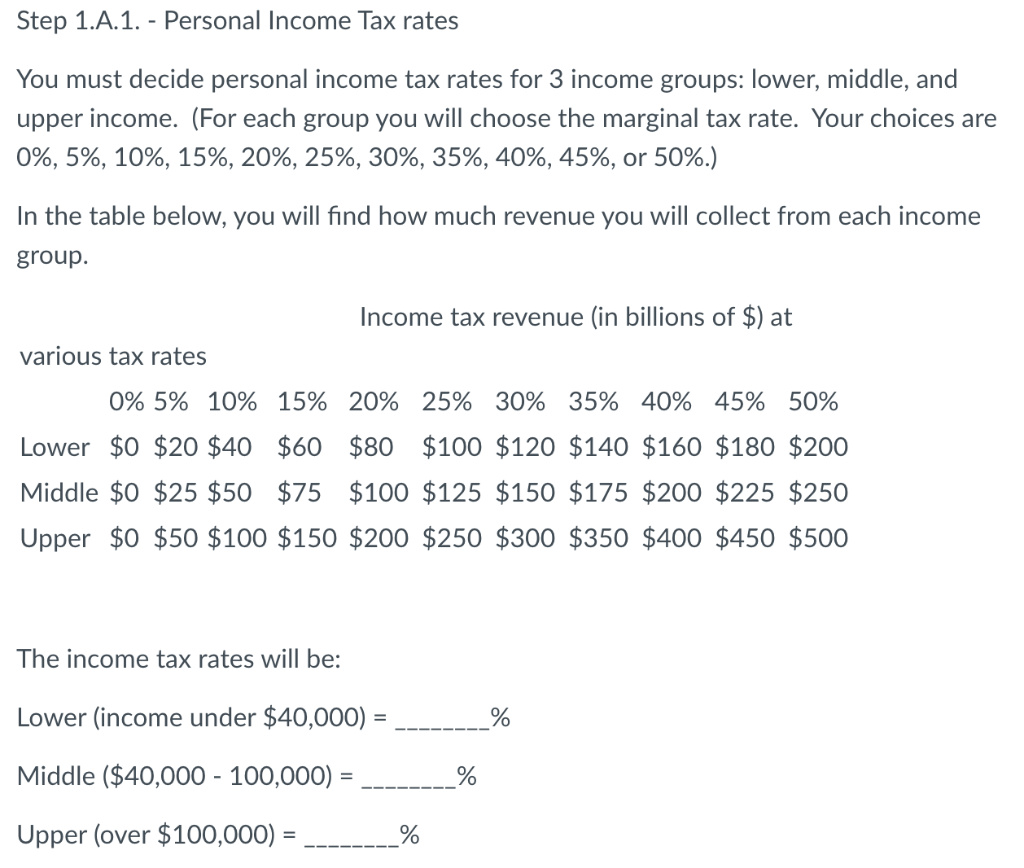


Step 1.A.1. - Personal Income Tax rates You must decide personal income tax rates for 3 income groups: lower, middle, and upper income. (For each group you will choose the marginal tax rate. Your choices are 0%, 5%, 10%, 15%, 20%, 25%, 30%, 35%, 40%, 45%, or 50%.) In the table below, you will find how much revenue you will collect from each income group. Income tax revenue (in billions of $) at various tax rates 0% 5% 10% 15% 20% 25% 30% 35% 40% 45% 50% Lower $0 $20 $40 $60 $80 $100 $120 $140 $160 $180 $200 Middle $0 $25 $50 $75 $100 $125 $150 $175 $200 $225 $250 Upper $0 $50 $100 $150 $200 $250 $300 $350 $400 $450 $500 The income tax rates will be: Lower (income under $40,000) = % Middle ($40,000 - 100,000) = % Upper (over $100,000) = % Referring to the table above, billion (middle) + Total income tax revenue $_ billion (upper) billion (lower) + $. _billion = $ To improve the tax incidence, you may go back to Step 1 and adjust your income, sale, and payroll tax rates so that your are satisfied with the effect on each income group. Once you have made final adjustments, classify your tax system. Is you overall system progressive, regressive, or proportional? Explain briefly. How can you justify this system? Step 1.A.1. - Personal Income Tax rates You must decide personal income tax rates for 3 income groups: lower, middle, and upper income. (For each group you will choose the marginal tax rate. Your choices are 0%, 5%, 10%, 15%, 20%, 25%, 30%, 35%, 40%, 45%, or 50%.) In the table below, you will find how much revenue you will collect from each income group. Income tax revenue (in billions of $) at various tax rates 0% 5% 10% 15% 20% 25% 30% 35% 40% 45% 50% Lower $0 $20 $40 $60 $80 $100 $120 $140 $160 $180 $200 Middle $0 $25 $50 $75 $100 $125 $150 $175 $200 $225 $250 Upper $0 $50 $100 $150 $200 $250 $300 $350 $400 $450 $500 The income tax rates will be: Lower (income under $40,000) = % Middle ($40,000 - 100,000) = % Upper (over $100,000) = % Referring to the table above, billion (middle) + Total income tax revenue $_ billion (upper) billion (lower) + $. _billion = $ To improve the tax incidence, you may go back to Step 1 and adjust your income, sale, and payroll tax rates so that your are satisfied with the effect on each income group. Once you have made final adjustments, classify your tax system. Is you overall system progressive, regressive, or proportional? Explain briefly. How can you justify this system









